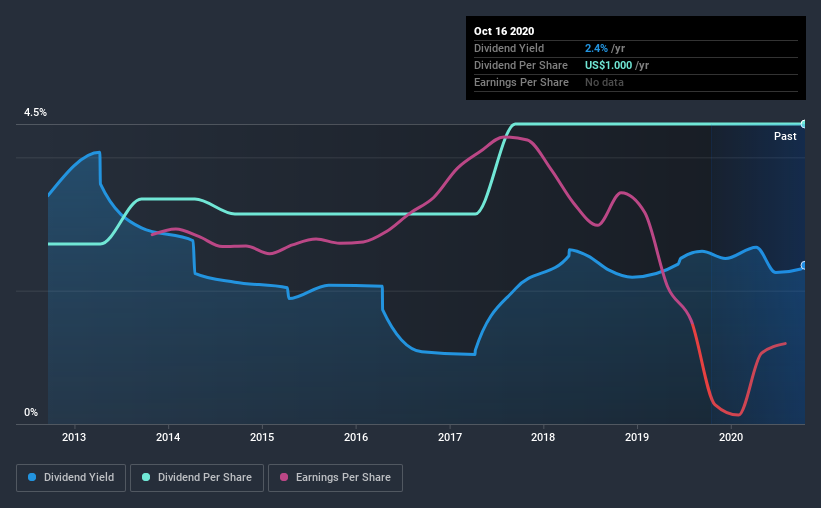Here's Why We're Wary Of Buying Argan's (NYSE:AGX) For Its Upcoming Dividend

Regular readers will know that we love our dividends at Simply Wall St, which is why it's exciting to see Argan, Inc. (NYSE:AGX) is about to trade ex-dividend in the next four days. Ex-dividend means that investors that purchase the stock on or after the 21st of October will not receive this dividend, which will be paid on the 30th of October.
Argan's next dividend payment will be US$0.25 per share, and in the last 12 months, the company paid a total of US$1.00 per share. Last year's total dividend payments show that Argan has a trailing yield of 2.4% on the current share price of $42. Dividends are a major contributor to investment returns for long term holders, but only if the dividend continues to be paid. So we need to check whether the dividend payments are covered, and if earnings are growing.
See our latest analysis for Argan
If a company pays out more in dividends than it earned, then the dividend might become unsustainable - hardly an ideal situation. Argan's dividend is not well covered by earnings, as the company lost money last year. This is not a sustainable state of affairs, so it would be worth investigating if earnings are expected to recover. Considering the lack of profitability, we also need to check if the company generated enough cash flow to cover the dividend payment. If cash earnings don't cover the dividend, the company would have to pay dividends out of cash in the bank, or by borrowing money, neither of which is long-term sustainable. It paid out 3.8% of its free cash flow as dividends last year, which is conservatively low.
Click here to see the company's payout ratio, plus analyst estimates of its future dividends.
Have Earnings And Dividends Been Growing?
When earnings decline, dividend companies become much harder to analyse and own safely. If business enters a downturn and the dividend is cut, the company could see its value fall precipitously. Argan was unprofitable last year and, unfortunately, the general trend suggests its earnings have been in decline over the last five years, making us wonder if the dividend is sustainable at all.
The main way most investors will assess a company's dividend prospects is by checking the historical rate of dividend growth. Argan has delivered an average of 6.6% per year annual increase in its dividend, based on the past eight years of dividend payments.
Remember, you can always get a snapshot of Argan's financial health, by checking our visualisation of its financial health, here.
Final Takeaway
Has Argan got what it takes to maintain its dividend payments? First, it's not great to see the company paying a dividend despite being loss-making over the last year. On the plus side, the dividend was covered by free cash flow." It's not the most attractive proposition from a dividend perspective, and we'd probably give this one a miss for now.
Having said that, if you're looking at this stock without much concern for the dividend, you should still be familiar of the risks involved with Argan. For example - Argan has 2 warning signs we think you should be aware of.
A common investment mistake is buying the first interesting stock you see. Here you can find a list of promising dividend stocks with a greater than 2% yield and an upcoming dividend.
This article by Simply Wall St is general in nature. It does not constitute a recommendation to buy or sell any stock, and does not take account of your objectives, or your financial situation. We aim to bring you long-term focused analysis driven by fundamental data. Note that our analysis may not factor in the latest price-sensitive company announcements or qualitative material. Simply Wall St has no position in any stocks mentioned.
Have feedback on this article? Concerned about the content? Get in touch with us directly. Alternatively, email editorial-team@simplywallst.com.

 Yahoo Finance
Yahoo Finance 
